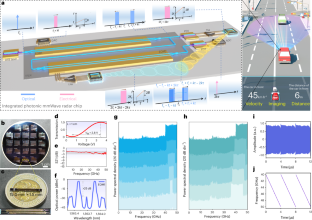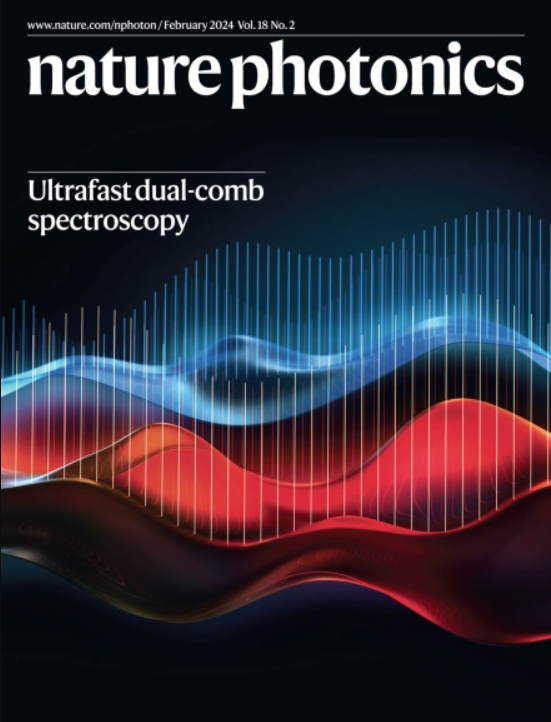集成铌酸锂光子毫米波雷达
IF 32.9
1区 物理与天体物理
Q1 OPTICS
引用次数: 0
摘要
毫米波(mmWave)雷达是即将到来的6G高分辨率传感和探测时代的关键推动者。传统的光子雷达大多是在由庞大的离散元件组成的桌面系统中实现的,而由于底层电光调制器的带宽和信号完整性不理想,更紧凑的集成光子雷达难以达到毫米波波段。在这里,我们克服了这些挑战,并展示了一种基于4英寸晶圆级薄膜铌酸锂(TFLN)技术的厘米分辨率紧凑型光子毫米波雷达。TFLN光子芯片包括第一电光调制器,用于通过光倍频产生宽带雷达波形,第二电光调制器用于对接收到的回波进行解调。这大大减轻了发射机中数模转换器和接收机中模数转换器的带宽要求。工作在毫米波V波段(40-50 GHz),我们实现了分辨率为1.50 cm的多目标测距和分辨率为0.067 m s - 1的速度测量。此外,我们还构建了一个二维分辨率为1.50 cm × 1.06 cm的逆合成孔径雷达。我们的集成TFLN光子毫米波雷达芯片在6G时代为车载雷达、机载雷达和智能家居的高分辨率传感和探测提供了紧凑且经济高效的解决方案。本文章由计算机程序翻译,如有差异,请以英文原文为准。


Integrated lithium niobate photonic millimetre-wave radar
Millimetre-wave (mmWave) radars are key enabler in the upcoming 6G era for high-resolution sensing and detection. Conventional photonic radars are mostly realized in tabletop systems composed of bulky discrete components, whereas the more compact integrated photonic radars are difficult to reach the mmWave bands owing to the unsatisfactory bandwidths and signal integrity of the underlying electro-optic modulators. Here we overcome these challenges and demonstrate a centimetre-resolution compact photonic mmWave radar based on a 4-inch wafer-scale thin-film lithium niobate (TFLN) technology. The TFLN photonic chip consists of a first electro-optic modulator for generating broadband radar waveforms via optical frequency multiplication, and a second modulator for de-chirping the received echoes. This greatly relieves the bandwidth requirements for the digital-to-analogue converter in the transmitter and analogue-to-digital converter in the receiver. Operating in the mmWave V band (40–50 GHz), we achieve multi-target ranging with a resolution of 1.50 cm and velocity measurement with a resolution of 0.067 m s−1. Furthermore, we construct an inverse synthetic aperture radar with a two-dimensional resolution of 1.50 cm × 1.06 cm. Our integrated TFLN photonic mmWave radar chip provides a compact and cost-effective solution in the 6G era for high-resolution sensing and detection in vehicle radar, airborne radar and smart homes. Researchers demonstrate a compact photonic mmWave radar based on a 4-inch wafer-scale thin-film lithium niobate technology. Multi-target ranging with 1.50 cm resolution and velocity measurement with a resolution of 0.067 m s−1 are achieved. An inverse synthetic aperture radar with a two-dimensional resolution of 1.50 cm × 1.06 cm is also demonstrated.
求助全文
通过发布文献求助,成功后即可免费获取论文全文。
去求助
来源期刊

Nature Photonics
物理-光学
CiteScore
54.20
自引率
1.70%
发文量
158
审稿时长
12 months
期刊介绍:
Nature Photonics is a monthly journal dedicated to the scientific study and application of light, known as Photonics. It publishes top-quality, peer-reviewed research across all areas of light generation, manipulation, and detection.
The journal encompasses research into the fundamental properties of light and its interactions with matter, as well as the latest developments in optoelectronic devices and emerging photonics applications. Topics covered include lasers, LEDs, imaging, detectors, optoelectronic devices, quantum optics, biophotonics, optical data storage, spectroscopy, fiber optics, solar energy, displays, terahertz technology, nonlinear optics, plasmonics, nanophotonics, and X-rays.
In addition to research papers and review articles summarizing scientific findings in optoelectronics, Nature Photonics also features News and Views pieces and research highlights. It uniquely includes articles on the business aspects of the industry, such as technology commercialization and market analysis, offering a comprehensive perspective on the field.
 求助内容:
求助内容: 应助结果提醒方式:
应助结果提醒方式:


